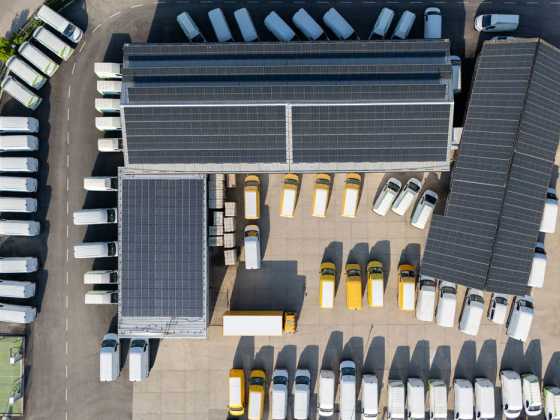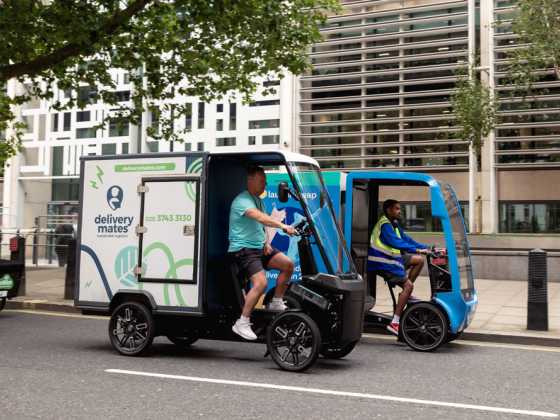Following the journey of the green bus
Innovation and supportive policy over the last decade has transformed the bus sector from being a part of the problem of poor urban air quality to being an important part of the solution. GreenFleet analyses the LowCVP report on the issue and looks at the wider global picture.
 Buses have historically contributed up to a third of nitrogen oxides (NOx) pollution in areas experiencing heavy traffic (more than a third in parts of London). However, over the last few years, an array of greener, cleaner buses have arrived on UK roads. Air pollution caused by vehicles is not a new issue, although its prominence has risen considerably in the last two years or so. Road transport is the main source of many air pollutants which impact local air quality – with NOx and particulates (PM) of growing concern. Such pollution negatively effects basic health, as well as adding to the risk of heart and lung disease, and lowering life expectancy.
Buses have historically contributed up to a third of nitrogen oxides (NOx) pollution in areas experiencing heavy traffic (more than a third in parts of London). However, over the last few years, an array of greener, cleaner buses have arrived on UK roads. Air pollution caused by vehicles is not a new issue, although its prominence has risen considerably in the last two years or so. Road transport is the main source of many air pollutants which impact local air quality – with NOx and particulates (PM) of growing concern. Such pollution negatively effects basic health, as well as adding to the risk of heart and lung disease, and lowering life expectancy.
Following the news of successful bids for an estimated £7 million of Department for Transport (DfT) funding in January this year, 439 buses in England will be fitted with green technology to cut harmful emissions by up to 90 per cent. The Clean Bus Technology Fund 2015 will be awarded to 18 local authorities across England, enabling 439 buses with technology to reduce nitrogen oxide emissions in pollution hotspots.
Clean Bus Technology Fund
The move, which will significantly improve air quality in town and city centres with the upgraded buses, is set to complete more than one million greener journeys annually. The Clean Bus Technology Fund is a core part of the government’s commitment to green transport which has seen £2 billion worth of measures introduced since 2011. The move will also add to the government’s £600 million investment in low-emission technology over the next five years, which aims to make almost every car and van zero emissions by 2050.
One area benefiting from green bus technology is Bristol, which has launched two state-of-the-art, low emission electric buses in partnership with the DfT, Bristol City Council and the University of West of England (UWE). The new vehicles run in areas of low air quality and use Geo-Fencing GPS technology to run on pure electric mode, producing zero emissions. There are only five of such vehicles in the UK, with two in Bristol and three in London also on a trial basis.
The buses run quietly and can be recognised by their striking blue colour and ‘electricity’ branding. Furthermore, the buses can charge once they reach their terminus, UWE’s French Campus, via a special plate in the ground which enables them to charge wirelessly.
George Ferguson, Mayor of Bristol, said: “This adds to Bristol’s growing reputation as a laboratory for change and an environmental innovator. These clean tech vehicles will help to reduce pollution and improve the health of the city, and are part of the continuing impact of our highly successful year as European Green Capital 2015.
“My goal is for Bristol to be one of the healthiest cities in the world and that has to start with us breathing clean air. I am confident this trial of new technology will pave the way for the future of electric buses in Bristol and beyond, adding to the many new sustainable transport initiatives that are currently taking place across the city.”
The Green Bus report
Maintaining our ability to move around in ever more congested towns and cities is more critical today than ever before. While a wide range of transport options now exist, there’s no doubt that an effective bus operation can deliver one of the best solutions to the challenges of air quality, climate change, congestion, convenience and, of course, cost. Bus travel has evolved with the development of the green buses of today. The Journey of the Green Bus explains how the last 20 years have transformed the emissions, efficiency and experience of buses.
Commissioned by Greener Journeys, the LowCVP report, The Journey of the Green Bus describes how innovation and supportive policy over the last decade has transformed the bus sector from being a part of the problem to being an important part of the solution to poor urban air quality, as well as contributing to tackling climate change.
A UK Low Emission Bus is defined as a vehicle which can achieve a reduction of more than 15 per cent well-to‑wheel greenhouse gas emissions compared with a Euro V diesel bus, as well as the Euro VI HD engine standard for pollutant emissions. With latest research by the Department for Environment, Food and Rural Affairs (Defra) showing that at least five regions in the UK are still facing an immense challenge in meeting European air quality standards for nitrogen dioxide (NO2), this report is a welcome aid for the sector.
A new generation of buses is dramatically improving emissions and lowering health risks thanks to advancing technologies and stringent real-world testing. While there is much more to be done, the arrival and expansion of the green bus is making, and will continue to make, a vital contribution to improving air quality in the UK.
National Air Quality Awards Passenger Transport Air Quality Award
Last year, bus manufacturer Optare won the National Air Quality Awards Passenger Transport Air Quality Award for the development of its electric bus range. The accolade reflects efforts to improve the UK’s air quality, in the charity, private or public sectors and the awards are supported by the Institute of Air Quality Management (IAQM), and the British Lung Foundation. The North Yorkshire company also picked up two awards from the LowCVP: the Heavy Duty Vehicle Manufacturer of the Year and Outstanding Achievement in Low Carbon Transport. Optare has 88 electric vehicles in operation in both the UK and across Europe and are said to reduce well‑to‑wheel carbon footprint by over 50 per cent in comparison with equivalent diesels.
Outside of the UK, the first stop of the green bus journey was made some time ago. The Far East in particular has seen sizeable developments in the low emission bus sector, with electrically-powered buses notably appearing in many countries. China and Japan have led the market, with Ankai recently securing a deal with Xuzhou Public Transport for 100 electric buses. Its HFF6800GEVB1 electric bus has been gaining in popularity thanks to the current drive in China for an integrated public transport system for both urban as well as rural areas. Ankai hopes to produce around 6,000 of the low emission bus per year, and has also developed a range of low emission models, including pure electric and plug-in hybrid variants.
World’s largest fast‑charging station
Elsewhere in China, electric-car maker BYD Co Ltd has opened a new commercial vehicle factory in Qingdao, Shandong province which is expected to construct up to 5,000 electrically-powered buses annually. Meanwhile, industrial aluminium extrusion product developer China Zhongwang and Brilliance Bus (Dalian) Company Limited have collaborated on a new electric bus, largely made from aluminium to improve energy consumption and give a longer range. Although only two prototypes have been built, mass production is expected. Which is timely, as China State Grid has opened the world’s largest fast-charging station in Beijing. The complex at Xiaoying Terminal has 25 360kW chargers and five 90kW points – the 26,500m2 site is capable of recharging up to 30 buses with Microvast batteries at any one time, which can take as little time as 10 minutes.
Ten minutes may be fast, but it’s nothing compared to electric buses which have recently been put into service in Ningbo, Zhejiang Province. These fast-chargers made by Zhuzhou Electric Locomotive take an unbelievable 10 seconds to fully charge, thanks to super capacitor technology. The bus charges when stationary, with each charge allowing around 3 miles of range. It also regeneratively converts more than 80 per cent of its braking and slowing energy, cutting energy consumption by up to 50 per cent when compared to a conventionally-engined bus.
Cable-free contactless charger
In Tokyo, Toshiba Corporation has developed a cable-free contactless charger for electric vehicles, and has started testing the technology on medium-sized electric buses. The trials run until December 2016 from the business centre of ANA in Tonomachi, Kawasaki and Haneda Airport. The 45‑seat buses which run on the seven-mile route are powered by a Toshiba 52.9kWh lithium‑ion SCiB™ rechargeable battery, while the contactless charger replaces conventional electromagnetic induction with a magnetic resonance system which is installed in the road surface. Once the bus is aligned with the charging pad, charging is started with the press of a button. Toshiba quotes a 55-mile range, while charging time is reported to be just 15 minutes.
It’s not just electric buses which are benefiting from continuous development. Last summer Toyota and Hino Motors Ltd carried out field tests in Tokyo of their fuel cell bus. The aim of the tests was to determine efficiency of the vehicle itself as well as practicality in the real world. This Japanese fuel cell bus is based on a Hino hybrid bus which is fitted with a Toyota Fuel Cell System, similar to that of the company’s Mirai fuel cell car, which is currently in production and is on sale in the UK. A pair of 110kW fuel cell stacks and 110kW (247lb ft/335Nm) motors feature in the collaborative project vehicle along with eight 70MPa high-pressure hydrogen tanks, a NiMH drive battery, and a 9.8kW/DC300 V vehicle-to-home (V2H) system.
Three-fold low emission rise
Back in the UK, the Society of Motor Manufacturers and Traders published similar findings in January to those of the LowCVP. It reported that the UK bus sector has enjoyed a three-fold rise in low emission vehicles, with 53.3 per cent of new buses registered in 2015 deploying the latest low emission Euro VI technology. Encouragingly, fleets boosted the uptake of advanced diesel engines by 307 per cent compared with just two years ago. As with the LowCVP report, the SMMT statement points to improved air quality offered by the latest technology. The latest rise in demand, says SMMT, comes as the regulatory period of grace which has permitted fleet operators to specify older technologies is due to end.
Just over half of operators in London now have vehicles with Euro VI technology, with four out of five buses in both Birmingham and Glasgow now running Euro VI engines. Mike Hawes, SMMT chief executive, said: “Industry has invested billions of pounds in advanced vehicle technology that delivers real results so it is encouraging to see this rapid uptake of Euro VI in the UK. The UK automotive sector remains committed to working alongside operators, government and local councils to encourage widespread adoption of the latest vehicles that will help dramatically improve the air quality in our towns and cities.”
Significant air quality improvements
Euro VI buses and coaches can deliver significant air quality improvements. The cleaner technology drastically reduces Nitrogen Oxides (NOx) emissions which are now seen as harmful to human health, while up to 99 per cent of soot particles can be captured. A decrease in NOx emissions of 95 per cent has been recorded by Transport for London on its 159 bus routes, thanks to the new low emission Euro VI vehicles.
But, wherever in the world they may be, the adoption of the latest low and ultra-low emission buses and technology is essential to improve air quality in towns and cities across the globe.
Further information
bit.ly/2aeUR4n






